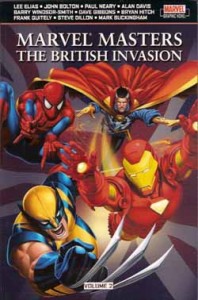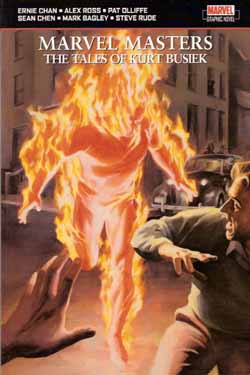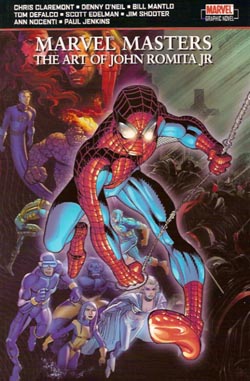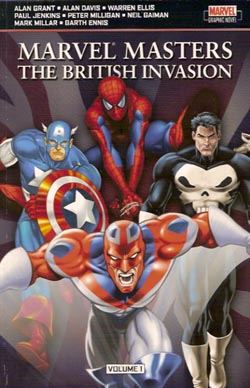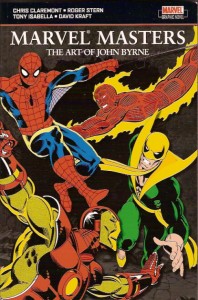
By various & John Byrne/Panini UK)
ISBN: 978-1-84653-400-3
John Byrne is one of the most prolific and creative talents in the American industry and has worked on every major character in both DC and Marvel’s pantheon as well as on creator owned properties. Since his professional debut as an artist at Skywald magazines (‘The Castle‘ in Nightmare #20, 1974) he subsequent worked for Nicola Cuti at Charlton Comics, where he produced Rog-2000 strips for E-Man, Wheelie and the Chopper Bunch, Space:1999, Emergency and the post-Apocalyptic classic Doomsday+1 before making the jump to Marvel. Along the way he developed a reputation for being difficult but always entertaining and a solid fan-favourite.
His first work for the House of Ideas opens this volume; a horror short plotted by Tony Isabella, scripted by David Kraft and inked by Rudy Nebres. ‘Dark Asylum‘ appeared in Giant-Sized Dracula # 5 (cover-dated June 1975) an inauspicious start as the Philippino’s heavy inking style utterly masked Byrne’s equally unique manner of drawing.
It’s not much better in the second tale printed herein, where the equally strong brush of veteran Al McWilliams defuses much of the penciller’s individuality. ‘Morning of the Mindstorm!’ is written by Chris Claremont, the last Iron Fist tale in Marvel Premiere (#25, October 1975) before the martial arts superhero graduated to his own title.
Regrettably none of those superb tales made it into this compendium, but a two-part tale from the artist’s stellar run on Marvel Team-Up (#61-62, September and October 1977) did. Pitting Spider-Man, the Human Torch and Ms. Marvel against the Super-Skrull ‘Not All Thy Power Can Save Thee!‘ and ‘All This and the QE2‘ is a solid action-thriller from scripter Claremont with inks by Dave Hunt.
Byrne’s place in comics history was secured by his incredible six year collaboration with Claremont on the X-Men. For most fans the high-point of this run was the “Dark Phoenix†multi-part epic. To acknowledge this, the concluding episode ‘The Fate of the Phoenix‘ (Uncanny X-Men #137, September, 1980, inked by Terry Austin) is included here, and even as a stand-alone tale, it still resonates with power, wonder and majesty.
The Byrne/Claremont partnership was experiencing some stress by 1981 and a parting of the ways was imminent. The artist undertook a short but magnificent run on the Star-Spangled Avenger (collected in its magical entirety as Captain America: War and Remembrance ISBN: 0-87135-657-0), and from that sequence comes the slyly witty ‘Cap for President‘ written by old-friend Roger Stern with inking by Joe Rubenstein.
In 1981 John Byrne achieved a private dream of relatively complete autonomy when he was assigned all the creative chores on Marvel’s flagship book. From November of that year comes his fifth issue as writer and artist. ‘Terror in a Tiny Town‘ is a 40 page epic to celebrate the twentieth anniversary of the Fantastic Four (#236, November, 1981) a classic confrontation with Doctor Doom and Puppet Master; still one of the very best non-Jack Kirby FF’s ever published.
Whilst working on X-Men, Byrne had created a team of Canadian super-heroes. When they were given their own series Byrne was again responsible for the total creative – if not editorial – output. ‘…And One Shall Surely Die‘ (Alpha Flight #12, July 1984) signalled the tragic, heroic end of the team’s leader (although no one dies forever in comics), another gripping extra-long extravaganza.
In 1985 Byrne drew Avengers Annual #14 (scripted by Stern and inked by Kyle Baker) as part of a major plot-line that guest-starred the Fantastic Four. ‘Fifth Column‘ featured a landmark change to the Marvel Universe and seemed to end the menace of the shape-shifting Skrulls forever…
Byrne took charge of The Incredible Hulk in 1986, trading Alpha Flight for the Jade Giant, but infamously clashed with the editor over story direction. Only six issues resulted before the creator left for DC and the revamping of Superman, but that half-dozen tales were fierce and gripping, promising a vast change that never came… From #319 comes ‘Member of the Wedding‘ (May 1986, with background inks from Keith Williams) wherein the fate-tossed Bruce Banner finally, Finally, FINALLY married his tragic sweetheart Betty Ross.
Byrne returned to Marvel in 1988, and revived She-Hulk – a character he had made a staple of the FF and a fan favourite. ‘Second Chance‘ (The Sensational She-Hulk volume 2, #1, May 1988) is a charming tip-of-the-hat to halcyon days featuring the Ringmaster and the Circus of Evil, written and drawn by Byrne with inks by Bob Wiacek. Displaying a touch for comedy, he turned this series into a surreal, fan-teasing example of fourth wall buffoonery, exploring the dafter corners of the Marvel Universe, but once again he fell afoul of what he felt was editorial interference.
Two years later he revolutionised one of Marvel’s earliest and greatest characters. Namor, the Sub-Mariner had been a chimerical hero/villain since Stan Lee and Jack Kirby had revived him in FF#4, but with ‘Purpose‘ (#1, April 1990) Byrne and inker Wiacek took firm hold of all the contradictions and blind alleys of the oldest of Marvel super-heroes and made him readable and compelling once again.
This volume ends with the last issue of Byrne’s last work for Marvel. Again editorial problems were the cited cause: when the excellent X-Men: the Hidden Years was arbitrarily cancelled with little or no warning Byrne severed all ties with Marvel. Crafted in homage to the Roy Thomas/Neal Adams/Tom Palmer run on the Merry Mutants the series filled in the gaps between the cancellation of the first series and the revival by Len Wein, Chris Claremont and Dave Cockrum in Giant-Sized X-Men #1.
From #22 (September 2001) comes ‘Friends and Enemies‘, the second of two parts – and as this book is already a huge 276 pages, surely a measly 22 more could have been found for the first half of the story? It finds Cyclops, Marvel Girl, Angel, Beast and Iceman battling the Mole Man whilst Professor X and guests Sub-Mariner and the FF defeat Magneto and the armies of Atlantis (a slick interweaving with the storyline of Fantastic Four #102-104). With inks by the legendary Tom Palmer this is a delightful taste of simpler times and proof that the entire series is well-worthy of its own collection someday soon. The book concludes with another sterling comprehensive career feature from comics historian Mike Conroy.
John Byrne, for all his curmudgeonly reputation, is a major creator and a cornerstone of the post-Kirby Marvel Universe. With such a huge back-catalogue of work to choose from this book succeeds in whetting the appetite, but a second volume really shouldn’t be too far behind…
Â
© 2008 Marvel Characters, Inc. All Rights Reserved. (A BRITISH EDITION BY PANINI UK LTD)

